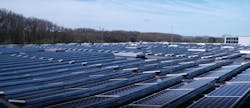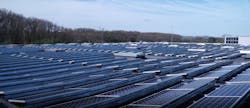One of the best ways to get some sustainability experience is to take on a roll-your-own, do-it-yourself project that teach about unfamiliar processes and solutions. It can also give some much-needed solidity to less-tangible promises and plans. For instance, Phoenix Contact installed a 960-kilowatt photovoltaic (PV) array in 2021 with more than 2,600 panels on the roof of its logistics center at its U.S. headquarters near Harrisburg, Pa. It cost about $1 million, but received government grants that were key to securing corporate buy-in.
Similar to any large distributed energy resources (DER), the array requires continuous, segment-level monitoring and control to maintain day-to-day efficiency and plan predictive maintenance. Its I/O points gather information on the PV system’s inverters, cameras, string currents and voltage, PV module soiling, temperature and weather (Figure 1). The array is integrated with the company’s building management system (BMS).
To monitor and control its PV array, provide alerts, and collect and analyze data, Phoenix Contact’s facilities management team looked in-house to its own engineering services department. Phoenix Contact also has more than 20 years of solar power experience, so its PV array also highlights its related products and services. For example, PV functions are managed by its PLCnext controller, which aggregate data from its I/O modules and EMpro meters, and transmit it to a cloud-computing service for analysis by the company or third-parties. Meanwhile, an industrial PC runs SCADA software that gathers data for history and long-term trending, and its Solarworx software manages solar power data and supports communications.
Network and monitor
- Operational status and faults for 12 inverters, as well as array performance metrics, including DC input power, AC output power, and active and reactive power.
- Current and voltage from the six strings at each inverter.
- Meteorological data, including wind speed and direction, air temperature and pressure and relative humidity.
- Solar irradiance that’s measured by two pyranometers—one horizontal and one at a 10° angle similar to the panels.
- Soiling sensor: High-quality instrument designed for measuring the light loss resulting from the soiling of the panels.
- Panel temperatures by multiple sensors.
- Feed-in control for overall power grids stability. PGS controllers record voltage and reactive power present at grid connection points and determine corresponding control values for the inverters. (This capability isn’t used at present due to local restrictions, but its data is available if and when it’s needed.)
“While our overall energy demand presently exceeds our maximum solar output, when you combine it with our 1 MW of microturbine generation, there are times during the year when we can provide electricity back to the utility via net metering, and be compensated for this generation,” explains Doug Ferguson, senior VP of Americas operations services at Phoenix Contact. Though the PV array is expected to meet 30% of the facility’s needs, the company also runs five, natural gas-powered microturbines to match loads it can’t handle.
Phoenix Contact plans for the Harrisburg campus to be carbon-neutral by 2030, and data from its PV monitoring system will help chart its progress. Likewise, information from its U.S. operations will be shared with its headquarters in Germany to contribute to reaching its global sustainability targets.
“Many environmental factors can degrade the production of a PV system, such as dust, snow and outside temperatures. Having environmental data monitoring on our system lets us offset expected daily production relative to real-world conditions,” says Russ Kolacek, building automation engineer at Phoenix Contact. “Every bit of energy from each diversified source helps. When our system is running efficiently and generating expected quantities of energy, it’s enough that—when combined with our microturbine generators—we produce all our own power independent of the utility grid.”
Sustainability series 2023
This article is part of the 2023 series on sustainability. Read more here.
About the Author

Leaders relevant to this article:


